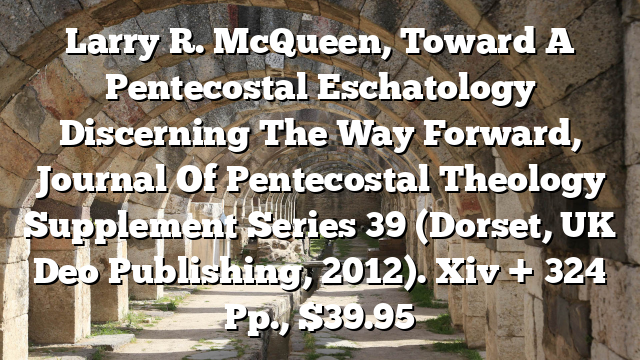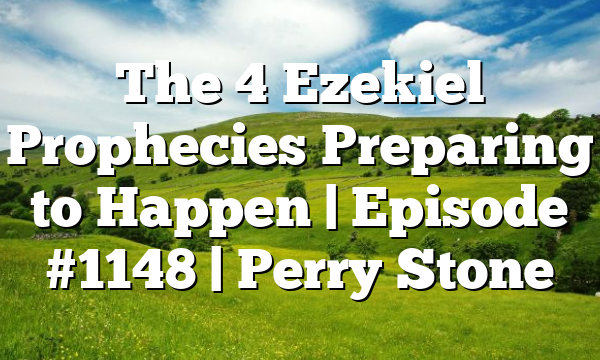Click to join the conversation with over 500,000 Pentecostal believers and scholars
Click to get our FREE MOBILE APP and stay connected
| PentecostalTheology.com



Pneuma 35 (2013)253-314
Book Reviews
Larry R. McQueen, Toward a Pentecostal Eschatology: Discerning the Way Forward, Journal of Pentecostal Theology Supplement Series 39 (Dorset, UK: Deo Publishing, 2012). xiv + 324 pp., $39.95 paperback.
Larry McQueen’s publication of his dissertation from Bangor University adds to the growing body of literature exploring Pentecostal eschatology. His goal is to push the discussion for- ward through an examination of early Pentecostal periodical literature and to provide bibli- cal support for the eschatological developments in Pentecostal theology. To accomplish his goal, McQueen organizes the book into four major chapters. Chapter one offers a discipline- specific literature review of current approaches in Pentecostal eschatology. He identifies three trends: those who fully embrace classical dispensationalism; those who argue for a modified dispensational eschatology that accounts for some Pentecostal distinctives; and those who reject classical dispensationalism and attempt to construct an eschatological framework from a Pentecostal self-understanding.
Chapter two and three interrogate early Pentecostal periodicals. He categorizes periodi- cals associated with the Pentecostal holiness, finished work, and Oneness traditions. He then analyzes the eschatological views in each of the periodicals in order to differentiate the theological trends. McQueen discovers that the Pentecostal periodicals directly related to Azusa Street and the holiness traditions articulate a variety of eschatological positions, while the finished work and Oneness periodicals are fully committed to classical dispensa- tionalism. According to McQueen, the holiness commitment to the fivefold gospel is more robust because a number of theological accents are highlighted. However, the finished work and Oneness Pentecostals collapse the soteriological efficacy of Christ to the atonement. The death and resurrection of Christ then become the pattern for the ages to come, already accomplished according to a predefined script.
Criticizing current discussions for their lack of biblical engagement, the final chapter shifts to biblical theology and supports an eschatological foundation of the fivefold gospel. Salvation is viewed robustly to include not only individual but social, political, ecological and cosmic dimensions. Sanctification is viewed as the eschatological goal of divine fellow- ship that shapes the believer’s character. (Here McQueen could have also developed the notion of sanctification in social, political and cosmic terms). Spirit baptism enables pneu- matic discernment and faithful witness in Christ in the last days amidst conflicts and perse- cutions. Healing affirms the materiality of salvation in the hoped-for resurrection of the body and transformation of creation in all its social, political and cosmic dimensions. The coming king looks to the reign of Christ as the alternative to Caesar’s Roman Empire, which will be judged by the risen Lord.
© Koninklijke Brill NV, Leiden, 2013
DOI: 10.1163/15700747-12341316
1
254
Book Reviews / Pneuma 35 (2013) 253-314
McQueen’s book is very good. He insightfully differentiates and analyzes the three streams in Pentecostalism. He also provides biblical support for constructing a Pentecostal eschatology around its understanding of the fivefold gospel. He accomplishes his goal and pushes the discussion of Pentecostal eschatology forward. For these reason the book is commendable.
However, the work is not without its problems; a number of theological presuppositions and methodological issues need further evaluation. First, McQueen’s use of early Pentecos- tal periodicals is understandable given that they are the main sources for researching the early movement, but he neglects to assess their biases, rhetoric and intended audience. As Allan Anderson has rightly noted, early Pentecostal writings are heavily weighted toward dominant voices in the West that have a vested interest in maintaining an authority struc- ture in relation to less dominant voices in the two thirds world (Anderson, Introduction to Pentecostalism, 2004).
Second, McQueen’s methodology is not consistent. Chapters three and four consist of a theo-historical interrogation of early Pentecostal literature. Specifically, he traces the escha- tological views in relation to the theological categories of the fivefold gospel for the holiness journals and atonement theology for the finished work journals. Chapter four abruptly shifts to biblical theology, where McQueen constructs a biblical foundation around the themes of savior, sanctifier, healer, Spirit baptizer, and coming king. In hindsight, however, it appears that McQueen approaches the early periodicals in a way similar to the interpretive method he uses for his biblical theology.
Finally, McQueen believes that he has found a clear distinction between holiness Pente- costals who articulate different eschatological positions and finished work Pentecostals who articulate a classical dispensational model (sometimes with modifications). However, his sources do not confirm this conclusion on two accounts. McQueen identifies Carrie Judd Montgomery as a finished work Pentecostal with a classical dispensational eschatology, but one of the quotes from Triumps of Faith reads: “. . . many of God’s little ones are beginning to realize a foretaste of resurrection quickening in their physical being, which fills them with glory, and yet with holy awe at the Divine condescension” (Montgomery as cited on 147). Although Montgomery uses the terms of rapture and dispensation, “foretaste” suggests that she also has a proleptic view of the resurrection in both its future and Easter sense. The second source that suggests more cross-fertilization than McQueen allows is the theology of holiness Pentecostal Hattie Barth, who speaks of the overlapping of dispensations like “links on a chain” (91). Once again, notions of “foretastes,” “foreshadow” and “anticipations” of the new age impinging on this age suggest a more proleptic view. However, Barth was also con- nected to the Assemblies of God. She was the founding principal of Beulah Heights Institute (1918), which, through a series of mergers, came to be what is now known as Southeastern University, an Assemblies of God school (Paul van der Laan, Southeastern University, 2010). These two examples suggest that the hard dispensational reading of the finished work camp may be overstated and that more cross-fertilization was taking place. The problem with the way that McQueen delineates his categories is that it is counterproductive to an ecumenical reading of early Pentecostalism.
2
Book Reviews / Pneuma 35 (2013) 253-314
255
These concerns notwithstanding, McQueen makes a fine contribution to the burgeoning research in Pentecostalism and helps to clarify the early genealogy of the movement, and he provides biblical support for the current developments in Pentecostal eschatology. Scholars and graduate students of Pentecostal theology and history will find it a helpful resource.
Reviewed by Peter Althouse
Associate Professor of Religion and Theology Southeastern University, Florida pfalthouse@seu.edu
3




Most Talked About Today